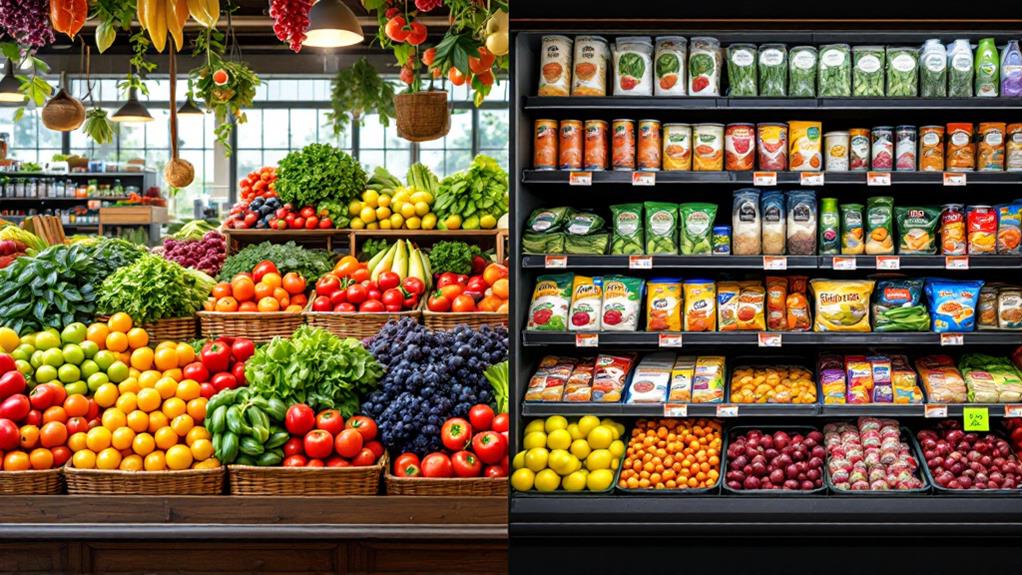Does Healthy Eating Cost More? Exploring the Real Cost of Nutritious Foods

Healthy eating might seem pricier initially, costing about $1.50 more per day. But in the long run, it saves money by reducing medical expenses and improving health. Nutrient-dense foods like beans and sweet potatoes are affordable and satisfying. Cooking at home and planning meals can cut costs considerably. While unhealthy diets may lead to chronic diseases with hefty medical bills, investing in nutritious foods is financially wise and supports better health outcomes. Following MyPlate guidelines is achievable on a budget, especially for middle-income families. Investigate how smart strategies and policy initiatives make nutritious eating more affordable.
Analyzing Food Cost Perception
In relation to understanding the cost of healthy eating, perception plays an important role. Many people believe that healthy foods are inherently more expensive than their unhealthy counterparts. This perception might stem from studies like the one from Harvard School of Public Health, which noted healthier diets cost about $1.50 more per day than less healthy diets. However, when you dig deeper, you'll find that nutrient-dense foods such as beans and sweet potatoes can be more affordable per portion. The real challenge lies in shifting this perception and understanding the true cost of a nutritious diet.
Economic studies reveal that while some healthy foods might seem costly upfront, the long-term financial benefits outweigh these initial expenses. By reducing the risk of chronic diseases associated with unhealthy diets, you save on future healthcare costs. Additionally, adopting strategies like cooking at home and sticking to a shopping list can help manage food prices effectively. For a middle-income family, aligning spending with MyPlate guidelines is feasible within their annual food budget. So, while the affordability of healthy eating might seem intimidating at the outset, it's vital to assess both the financial and health benefits over time.
Impact of Unhealthy Diets
Many people underestimate the profound impact that unhealthy diets can have on both personal health and finances. When you consume unhealthy foods, you're not just risking your health but also inviting a slew of chronic diseases like obesity, heart disease, and diabetes. These conditions greatly increase healthcare costs. Consider these facts:
- Increased Medical Expenses: Obese individuals face an average of $1,500 more in annual medical expenses compared to those maintaining a normal weight. If you have multiple chronic diseases, your annual medical expenses can skyrocket to $25,000, while healthier individuals typically incur around $6,000.
- Long-term Costs vs. Nutritious Diet: The long-term costs of treating chronic diseases often surpass the expenses associated with maintaining a nutritious diet. Investing in healthy foods now can lead to reduced future medical expenses, making it a financially sound choice.
- Economic Benefits of Healthy Eating: Improved diet quality not only reduces medical expenses but also improves general health outcomes. The economic benefits of consuming nutritious foods ultimately outweigh the perceived high food pricing.
Incorporating a nutritious diet into your lifestyle isn't just about immediate health benefits; it's an investment in your financial future.
Budget-Friendly Eating Tips

Recognizing the financial impact of unhealthy eating, it's time to contemplate practical ways to eat healthily without breaking the bank. Start with meal planning. By organizing your meals ahead of time, you can reduce food waste and save about $390 per year for a family of four. This guarantees you make the most of your ingredients, leading to more budget-friendly eating habits. Stick to a shopping list to avoid unplanned purchases, which can inflate your grocery bill by 10%.
Opt for cooking at home instead of dining out. Preparing meals yourself saves over $100 per person each month, making it an economical way to enjoy healthy foods. Engage in seasonal shopping for fruits and vegetables; you'll find that prices drop considerably when you buy these items in their peak seasons.
Don't shy away from store brand products. They can cut your food costs by around 25% without sacrificing quality, allowing you to enjoy nutritious food affordably. By adopting these strategies, you can maintain a balanced diet and keep your expenses low, proving that eating healthily doesn't have to be expensive.
Policy Approaches for Affordability
A range of policy approaches can greatly improve the affordability of healthy foods. By focusing on food pricing and economic incentives, governments can make nutritious foods more accessible, particularly for lower-income populations. Here are three effective strategies:
- Subsidies for Fruits and Vegetables: Implementing subsidies can considerably improve affordability and consumption of healthy foods. Studies show that subsidies increase fruit and vegetable consumption by 25%, empowering people to make healthier dietary choices without financial strain.
- Health-Related Food Taxes: Taxes on unhealthy items, like Mexico's excise tax on sugar-sweetened beverages, discourage the purchase of these products. This approach not only promotes healthier eating habits but can also lower total diet costs, leading to better public health outcomes.
- Collaborations Between Government and the Food Industry: These partnerships can streamline access to nutritious foods, ensuring that healthy options are available and affordable. By creating a supportive food environment through such collaborations, public health can improve, and healthcare costs related to diet-induced diseases can decrease.
These policy initiatives demonstrate that addressing affordability and access through extensive strategies can lead to healthier communities and more sustainable dietary choices. Prioritizing these efforts helps create a healthier future for everyone.
Enhancing Nutrition Education

Numerous initiatives focus on improving nutrition education to empower individuals with the knowledge and skills needed for healthier eating habits. By participating in nutrition education programs, you can learn about meal preparation techniques that emphasize nutrient-dense foods, such as sweet potatoes and dark leafy greens. These foods offer high nutrition at lower costs, making healthy eating more accessible. Educational initiatives highlight how cooking at home is often more cost-effective than dining out, helping you realize potential savings and encouraging healthier dietary habits.
Engaging community events offer practical experiences in healthy eating and waste reduction strategies. These events empower you to make informed dietary choices and minimize food waste. By understanding food pricing and spending patterns, you can select foods that optimize nutrition without straining your budget.
Collaborations between educational institutions and local communities improve access to resources and knowledge, supporting sustainable food practices. These partnerships guarantee you have the tools needed to maintain healthier dietary habits. With continuous education, you can navigate the challenges of food pricing and make smarter choices that benefit your health and wallet, proving that healthy eating doesn't have to be expensive.




